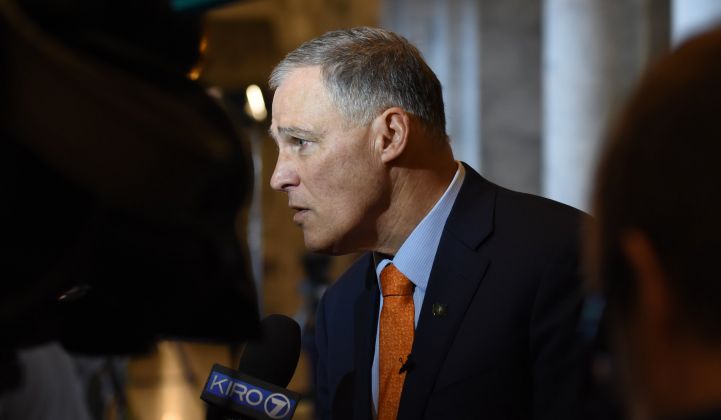Washington Governor and Democratic presidential candidate Jay Inslee released a lengthy plan to boost the U.S. economy with clean energy jobs, expanding on his recent policy proposal to decarbonize the nation’s electricity, buildings and vehicles.
The “Evergreen Economy” plan would pump federal dollars into building clean, resilient infrastructure and updating existing buildings. Inslee pays special attention to the marginalized communities that have borne the brunt of pollution and climate impacts, but also supports workers currently employed in fossil fuel industries.
Inslee argues that a nationwide decarbonization effort can bring about a major improvement in the lives of working people.
“After decades of erosion of workers’ rights, America must reset the balance that has disadvantaged working people for too long,” his plan notes.
Though just one candidate among an increasingly crowded field, Inslee has set a high bar for how deeply a politician can engage with climate change on the campaign trail. Only one other candidate, Beto O’Rourke, has released a detailed plan.
Whether or not Inslee wins the nomination and earns a chance to pursue his agenda at the national level, his ideas could shape how Democrats approach the issue.
Societal transformation
Inslee wants to use federal funds and influence both to alter certain aspects of the economy directly, and to incentivize private actors to change their behavior. He’s not as hands-on with the role of government as the Green New Deal resolution, which included a jobs guarantee, but still sees the government as a pivotal catalyst in the changes he wants to achieve.
Highlights include:
- ReBuild America program to employ “millions” of workers to retrofit existing buildings with energy-efficiency upgrades. At scale, the program would address 4 percent of buildings each year for 25 years.
- Decarbonizing the federal government. Require government agencies to purchase 100 percent clean power and vehicles by 2024. Instruct the Tennessee Valley Authority and other federal power producers to decarbonize their fleets.
- Allocate $90 billion to launch a federal Green Bank, which will provide low-cost loans and loan guarantees for clean energy projects.
- Enact incentives for clean energy as the federal Investment Tax Credit and Production Tax Credit step down. Inslee wants to use grants instead of tax credits, which could simplify and democratize the process compared to the current tax equity approach.
- Expand government research and development funding for clean technologies to $35 billion annually over the next decade.
The most sprawling and ambitious section tackles “climate-smart infrastructure,” including overhauls of the national transportation system, transmission and distribution grids, water infrastructure, sustainable housing and urban planning, and conservation of the nation’s landscapes and ecosystems.
Blue-collar appeal?
Candidates that advocate clean energy must navigate a tension between creating new jobs and eliminating old ones.
Hillary Clinton took flak in the 2016 election for noting that “we're going to put a lot of coal miners and coal companies out of business.” But her remarks at a CNN town hall were not a prescription but rather a description of ongoing trends, which she said should be addressed by building economic opportunity in coal country through clean energy. That message of helping coal miners didn’t break through.
Inslee’s plan puts the interests of those workers front and center. It proposes a “GI Bill” to support coal and gas workers throughout the energy transition, as their employers shut down operations or enter bankruptcy. This would include a social safety net of retirement benefits and health insurance, plus training and support to enter new jobs.
It’s not clear to what extent fossil fuel workers will buy into promises of care from the federal government. That said, casting this effort in the image of the GI Bill, which rewarded military service in World War II by providing veterans with funding for education, creates novel rhetorical opportunities. It recognizes and honors past service while preparing for a different future.
The Inslee plan does not join the Green New Deal resolution in demanding a federal jobs guarantee, but it packs in a series of proposals to boost the standing of organized labor.
That includes raising the federal minimum wage to $15 an hour and repealing the legal basis for “right-to-work” laws, which have curtailed the power of unions in states that approved them.
“Governor Inslee’s plan firmly establishes the American worker at the heart of our economy once again by creating millions of high-paying, high-skilled union jobs building a stronger, greener, and more sustainable economy, and empowering workers in every industry with new tools to collectively bargain, challenge racial and gender inequality, and close the gap between wealth and poverty,” the plan notes.
On its face, a transition to clean energy threatens the jobs that provide for the carbon-intensive economy. The states that succeeded in passing ambitious clean energy legislation, including Inslee's Washington, made inroads with organized labor first.




